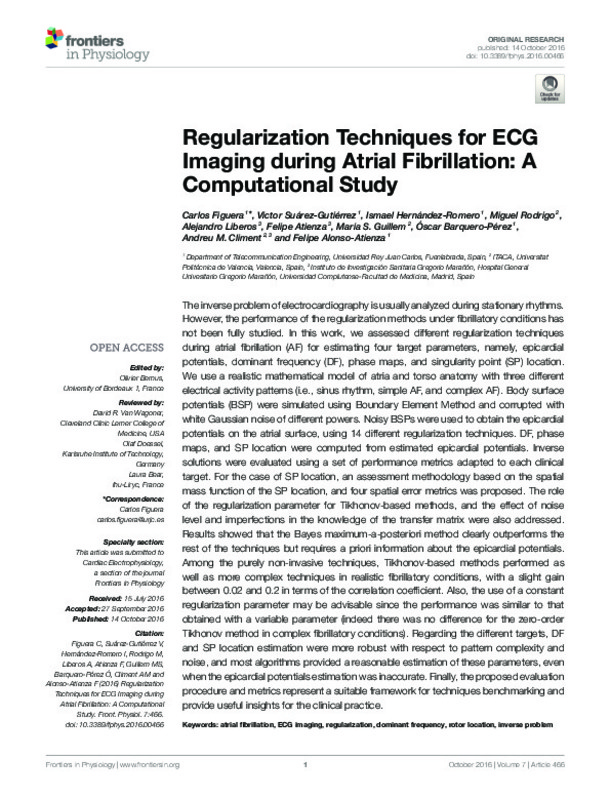JavaScript is disabled for your browser. Some features of this site may not work without it.
Buscar en RiuNet
Listar
Mi cuenta
Estadísticas
Ayuda RiuNet
Admin. UPV
Regularization Techniques for ECG Imaging during Atrial Fibrillation: A Computational Study
Mostrar el registro sencillo del ítem
Ficheros en el ítem
| dc.contributor.author | Figuera C
|
es_ES |
| dc.contributor.author | Suárez Gutiérrez V
|
es_ES |
| dc.contributor.author | Hernández-Romero, Ismael
|
es_ES |
| dc.contributor.author | Rodrigo Bort, Miguel
|
es_ES |
| dc.contributor.author | Liberos Mascarell, Alejandro
|
es_ES |
| dc.contributor.author | Atienza, F.
|
es_ES |
| dc.contributor.author | Guillem Sánchez, María Salud
|
es_ES |
| dc.contributor.author | Barquero-Pérez O
|
es_ES |
| dc.contributor.author | Climent, A.M.
|
es_ES |
| dc.contributor.author | Alonso Atienza, Felipe
|
es_ES |
| dc.date.accessioned | 2017-07-10T10:01:16Z | |
| dc.date.available | 2017-07-10T10:01:16Z | |
| dc.date.issued | 2016-10-14 | |
| dc.identifier.issn | 1664-042X | |
| dc.identifier.uri | http://hdl.handle.net/10251/84833 | |
| dc.description.abstract | The inverse problem of electrocardiography is usually analyzed during stationary rhythms. However, the performance of the regularization methods under fibrillatory conditions has not been fully studied. In this work, we assessed different regularization techniques during atrial fibrillation (AF) for estimating four target parameters, namely, epicardial potentials, dominant frequency (DF), phase maps, and singularity point (SP) location. We use a realistic mathematical model of atria and torso anatomy with three different electrical activity patterns (i.e., sinus rhythm, simple AF, and complex AF). Body surface potentials (BSP) were simulated using Boundary Element Method and corrupted with white Gaussian noise of different powers. Noisy BSPs were used to obtain the epicardial potentials on the atrial surface, using 14 different regularization techniques. DF, phase maps, and SP location were computed from estimated epicardial potentials. Inverse solutions were evaluated using a set of performance metrics adapted to each clinical target. For the case of SP location, an assessment methodology based on the spatial mass function of the SP location, and four spatial error metrics was proposed. The role of the regularization parameter for Tikhonov-based methods, and the effect of noise level and imperfections in the knowledge of the transfer matrix were also addressed. Results showed that the Bayes maximum-a-posteriori method clearly outperforms the rest of the techniques but requires a priori information about the epicardial potentials. Among the purely non-invasive techniques. Tikhonov-based methods performed as well as more complex techniques in realistic fibrillatory conditions, with a slight gain between 0.02 and 0.2 in terms of the correlation coefficient. Also, the use of a constant regularization parameter may be advisable since the performance was similar to that obtained with a variable parameter (indeed there was no difference for the zero-order Tikhonov method in complex fibrillatory conditions). Regarding the different targets. DF and SP location estimation were more robust with respect to pattern complexity and noise, and most algorithms provided a reasonable estimation of these parameters, even when the epicardial potentials estimation was inaccurate. Finally, the proposed evaluation procedure and metrics represent a suitable framework for techniques benchmarking and provide useful insights for the clinical practice. | es_ES |
| dc.description.sponsorship | This work has been partially supported by TEC2013-46067-R (Ministerio de Economia y Competitividad, Spanish Government). | en_EN |
| dc.language | Inglés | es_ES |
| dc.publisher | Frontiers Media | es_ES |
| dc.relation.ispartof | Frontiers in Physiology | es_ES |
| dc.rights | Reconocimiento (by) | es_ES |
| dc.subject | Atrial Fibrillation | es_ES |
| dc.subject | ECG imaging | es_ES |
| dc.subject | Regularization | es_ES |
| dc.subject | Dominant frequency | es_ES |
| dc.subject | Rotor location | es_ES |
| dc.subject | Inverse problem | es_ES |
| dc.subject.classification | TECNOLOGIA ELECTRONICA | es_ES |
| dc.title | Regularization Techniques for ECG Imaging during Atrial Fibrillation: A Computational Study | es_ES |
| dc.type | Artículo | es_ES |
| dc.identifier.doi | 10.3389/fphys.2016.00466 | |
| dc.relation.projectID | info:eu-repo/grantAgreement/EC/H2020/692023/EU/Linking excellence in biomedical knowledge and computational intelligence research for personalized management of CVD within PHC/ | |
| dc.relation.projectID | info:eu-repo/grantAgreement/MINECO//TEC2013-46067-R/ES/ESTIMACION NO INVASIVA DE LA ACTIVIDAD ELECTRICA CARDIACA MEDIANTE OPTIMIZACION CONVEXA/ | es_ES |
| dc.rights.accessRights | Abierto | es_ES |
| dc.contributor.affiliation | Universitat Politècnica de València. Instituto Universitario de Telecomunicación y Aplicaciones Multimedia - Institut Universitari de Telecomunicacions i Aplicacions Multimèdia | es_ES |
| dc.contributor.affiliation | Universitat Politècnica de València. Departamento de Ingeniería Electrónica - Departament d'Enginyeria Electrònica | es_ES |
| dc.description.bibliographicCitation | Figuera C; Suárez Gutiérrez V; Hernández-Romero, I.; Rodrigo Bort, M.; Liberos Mascarell, A.; Atienza, F.; Guillem Sánchez, MS.... (2016). Regularization Techniques for ECG Imaging during Atrial Fibrillation: A Computational Study. Frontiers in Physiology. 7(466):1-17. https://doi.org/10.3389/fphys.2016.00466 | es_ES |
| dc.description.accrualMethod | S | es_ES |
| dc.relation.publisherversion | http://doi.org/10.3389/fphys.2016.00466 | es_ES |
| dc.description.upvformatpinicio | 1 | es_ES |
| dc.description.upvformatpfin | 17 | es_ES |
| dc.type.version | info:eu-repo/semantics/publishedVersion | es_ES |
| dc.description.volume | 7 | es_ES |
| dc.description.issue | 466 | es_ES |
| dc.relation.senia | 324199 | es_ES |
| dc.identifier.pmid | 27790158 | en_EN |
| dc.identifier.pmcid | PMC5064166 | en_EN |
| dc.contributor.funder | Ministerio de Economía y Competitividad | es_ES |








